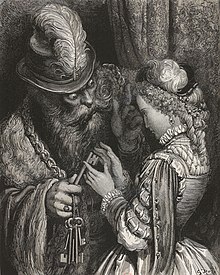
Bluebeard's Castle

| Bluebeard's Castle | |
|---|---|
| Opera by Béla Bartók | |
 Bluebeard and his wife in an illustration by Gustave Doré for Perrault's tale | |
| Native title | Hungarian: A kékszakállú herceg vára |
| Librettist | Béla Balázs |
| Language | Hungarian |
| Based on | La Barbe bleue by Charles Perrault |
| Premiere | 24 May 1918 Royal Hungarian Opera House, Budapest |
Duke Bluebeard's Castle (Hungarian: A kékszakállú herceg vára, literally The Blue-Bearded Duke's Castle) is a one-act Symbolist opera by composer Béla Bartók to a Hungarian libretto by his friend and poet Béla Balázs. Based on the French folk legend, or conte populaire, as told by Charles Perrault, it lasts about an hour and deploys just two singing characters: Bluebeard (Kékszakállú) and his newest wife Judith (Judit); the two have just eloped and she is coming home to his castle for the first time.

Bluebeard's Castle, Sz. 48, was composed in 1911 (with modifications made in 1912 and a new ending added in 1917) and first performed on 24 May 1918 at the Royal Hungarian Opera House in Budapest. published the vocal (1921) and full score (1925). The Boosey & Hawkes full score includes only the German and English singing translations while the Dover edition reproduces the Universal Edition Hungarian/German vocal score (with page numbers beginning at 1 instead of 5). A revision of the UE vocal score in 1963 added a new German translation by Wilhelm Ziegler, but seems not to have corrected any errata. Universal Edition and Bartók Records has published a new edition of the work in 2005 with a new English translation by Péter Bartók, accompanied by an extensive errata list.[1]

Composition history

Balázs originally conceived the libretto for his roommate Zoltán Kodály in 1908, and wrote it during the following two years. It was first published serially in 1910 with a joint dedication to Kodály and Bartók, and in 1912 appeared with the prologue in the collection "Mysteries". Bartók was motivated to complete the opera in 1911 by the closing date of the Ferenc Erkel Prize competition, for which it was duly entered. A second competition, organised by the music publishers Rózsavölgyi and with a closing date in 1912, encouraged Bartók to make some modifications to the work in order to submit it to the Rózsavölgyi competition.

Little is known about the Ferenc Erkel Prize other than that Bluebeard's Castle did not win. The Rózsavölgyi judges, after reviewing the composition, decided that the work (with only two characters and a single location) was not dramatic enough to be considered in the category for which it was entered: theatrical music. It is thought that the panel of judges who were to look at the musical (rather than the theatrical) aspects of the competition entries never saw Bartók's entry.

In 1913 Balázs produced a spoken performance at which Bartók played some piano pieces on a separate part of the program. A 1915 letter to Bartók's young wife, Márta, (to whom he dedicated the opera) ends: "Now I know that I will never hear it in this life. You asked me to play it for you—I am afraid I would not be able to get through it. Still I'll try so that we may mourn it together."[2]

Performance history
The success of the ballet The Wooden Prince in 1917 paved the way for the May 1918 première with the same conductor, Egisto Tango. Oszkár Kálmán was the first Bluebeard and Olga Haselbeck the first Judith. Following Balázs' exile in 1919 and the ban on his work there were no revivals until 1936. Bartók attended rehearsals and reportedly sided with the new Bluebeard, Mihály Székely, over the new conductor Sergio Failoni, who was insisting on fidelity to the printed score.

Productions in Germany followed in Frankfurt (1922) and Berlin (1929).[3]

Bluebeard's Castle was first performed in Italy at the Maggio Musicale Fiorentino on 5 May 1938. The production was conducted by Sergio Failoni and starred Mihály Székely in the title role and Ella Némethy as Judith. The Teatro di San Carlo mounted the opera for the first time under Ferenc Fricsay on 19 April 1951[3] with Mario Petri and Ira Malaniuk. The work's La Scala debut occurred on 28 January 1954 with Petri and Dorothy Dow. This was followed by several other productions at major opera houses in Italy, including the Teatro Regio di Torino (1961), Teatro dell'Opera di Roma (1962), Teatro Comunale di Bologna (1966), La Fenice (1967), and the Teatro Regio di Parma (1970).

The first American performance was by the Dallas Symphony Orchestra broadcast on NBC Radio's Orchestras of the Nation on 9 January 1949, followed by a concert performance at the Music Hall at Fair Park in Dallas, Texas, on 10 January. Both performances were led by conductor Antal Doráti, a former Bartók student.[4] Other sources mention a 1946 concert performance in Dallas.[5][6][7] The first fully staged American production was at the New York City Opera on 2 October 1952 with conductor Joseph Rosenstock and singers James Pease and Catherine Ayres.[8] The Metropolitan Opera mounted the opera for the first time on 10 June 1974 with conductor Sixten Ehrling and singers David Ward and Shirley Verrett.

The South American premiere was in Buenos Aires's Teatro Colón, 23 September 1953 conducted by Karl Böhm.[3]

Bluebeard's Castle received its French premiere on 17 April 1950 in a radio broadcast on Radiodiffusion-Télévision Française. Ernest Ansermet conducted the performance, which featured Renée Gilly as Judith and Lucien Lovano as Bluebeard. The first staged production of the work in France was at the Opéra national du Rhin on 29 April 1954 with Heinz Rehfuss in the title role, Elsa Cavelti as Judith, and conductor Ernest Bour. The first performance in Paris was at the Opéra-Comique on 8 October 1959[3] with soprano Berthe Monmart and bass Xavier Depraz. The production was directed by Marcel Lamy and used a French translation by Michel-Dimitri Calvocoressi.

The London première took place on 16 January 1957 at the Rudolf Steiner Theatre during the English tour of Scottish composer Erik Chisholm directing the University of Cape Town Opera Company whose Désirée Talbot was Judith. A few years earlier, Chisholm had premièred this work in South Africa at the Little Theatre in Cape Town.

The work was first performed in Japan on 29 April 1954 by the Youth Group of the Fujiwara Opera Company (under conductor Yoichiro Fukunaga with piano accompaniment). The opera was presented with full orchestra in the 348th regular concert of the NHK Symphony Orchestra on 16 March 1957.

The opera's Austrian premiere took place at the Salzburg Festival on 4 August 1978 with conductor George Alexander Albrecht, Walter Berry and Katalin Kasza.

In Israel, the opera premiered on 15 December 2010 at the New Israeli Opera in Tel Aviv. Vladimir Braun was Bluebeard[9] and Svetlana Sandler sang Judith.[10] Shirit Lee Weiss directed[11] and Ilan Volkov[12][failed verification] conducted. The sets, originally used in the Seattle Symphony's 2007 performance were designed by glass artist Dale Chihuly.

In 1988 the BBC broadcast an adaptation of the opera as Duke Bluebeard's Castle directed by Leslie Megahey. It starred Robert Lloyd as Bluebeard and Elizabeth Laurence as Judith.[13]

The Taiwanese première, directed and conducted by Tseng Dau-Hsiong, took place in the National Theater in Taipei on 30 December 2011.[14] In January 2015, the Metropolitan Opera presented its first production of Bluebeard's Castle in the original Hungarian, starring Mikhail Petrenko as Bluebeard and Nadja Michael as Judith. In 2022 the Teatro Colón of Buenos Aires broadcast a staging directed by Sophie Hunter.[15]

Roles
| Role | Voice type | Premiere cast, 24 May 1918 Conductor: Egisto Tango |
|---|---|---|
| Prologue of the Bard | spoken | |
| Bluebeard | bass or bass-baritone | Oszkár Kálmán |
| Judith | soprano or mezzo-soprano | Olga Haselbeck |
| Bluebeard's wives | silent |
Bartók includes the Castle on the dramatis personæ page.

Synopsis
- Place: A huge, dark hall in a castle, with seven locked doors.
- Time: Not defined.
Judith and Bluebeard arrive at his castle, which is all dark. Bluebeard asks Judith if she wants to stay and even offers her an opportunity to leave, but she decides to stay. Judith insists that all the doors be opened, to allow light to enter into the forbidding interior, insisting further that her demands are based on her love for Bluebeard. Bluebeard refuses, saying that there are private places not to be explored by others, and asking Judith to love him but ask no questions. Judith persists, and eventually prevails over his resistance.

The first door opens to reveal a torture chamber, stained with blood. Repelled, but then intrigued, Judith pushes on. Behind the second door is a storehouse of weapons, and behind the third a storehouse of riches. Bluebeard urges her on. Behind the fourth door is a secret garden of great beauty; behind the fifth, a window onto Bluebeard's vast kingdom. All is now sunlit, but blood has stained the riches, watered the garden, and grim clouds throw blood-red shadows over Bluebeard's kingdom.

Bluebeard pleads with her to stop: the castle is as bright as it can get, and will not get any brighter, but Judith refuses to be stopped after coming this far, and opens the penultimate sixth door, as a shadow passes over the castle. This is the first room that has not been somehow stained with blood; a silent silvery lake is all that lies within, "a lake of tears". Bluebeard begs Judith to simply love him, and ask no more questions. The last door must be shut forever. But she persists, asking him about his former wives, and then accusing him of having murdered them, suggesting that their blood was the blood everywhere, that their tears were those that filled the lake, and that their bodies lie behind the last door. At this, Bluebeard hands over the last key.

Behind the door are Bluebeard's three former wives, but still alive, dressed in crowns and jewellery. They emerge silently, and Bluebeard, overcome with emotion, prostrates himself before them and praises each in turn (as his wives of dawn, midday and dusk), finally turning to Judith and beginning to praise her as his fourth wife (of the night). She is horrified and begs him to stop, but it is too late. He dresses her in the jewellery they wear, which she finds exceedingly heavy. Her head drooping under the weight, she follows the other wives along a beam of moonlight through the seventh door. It closes behind her, and Bluebeard is left alone as all fades to total darkness.

Symbolism
The Hungarian conductor István Kertész believed that we should not relate this to the fairy tale on which it was based, but that Bluebeard was Bartók himself, and that it portrays his personal suffering and his reluctance to reveal the inner secrets of his soul, which are progressively invaded by Judith. In this way he can be seen as Everyman, although the composer himself was an intensely private man. Here the blood that pervades the story is the symbol of his suffering. The Prologue (often omitted) points to the story that is portrayed as occurring in the imagination of the audience. While Kertész felt Judith is a villain in this sense, Christa Ludwig, who had sung the role, disagreed, stating that she only voices all that she has heard about Bluebeard. She refers repeatedly to the rumours (hír), Jaj, igaz hír; suttogó hír (Ah, truthful whispered rumours). Ludwig also believed that Judith was telling the truth every time she says to him, Szeretlek! (I love you!).[16]

Another Judith, Nadja Michael, had a somewhat different, more symbolic interpretation. In a broadcast from the Metropolitan Opera on 14 February 2015, she stated that it does not matter who Judith is; she symbolises a human being who has to face up to all the fears that she brings from her past.[17]

In 2020, the Bayerische Staatsoper presented a transformed staging of Bluebeard's Castle into a work they titled "Judith". The opera is preceded by a film that sets up the revised drama, using Bartok's "Concerto for Orchestra" as the audio backdrop. Judith is a Police Detective and expert in undercover work. Instead of becoming Bluebeard's next victim, she frees the three previous wives and kills the perpetrator. The reinterpretation has received many positive reviews, such as this one.

Staging
Traditionally, the set is a single dark hall surrounded by the seven doors around the perimeter. As each door is opened, a stream of symbolically colored light comes forth (except in the case of the sixth door, for which the hall is actually darkened). The symbolic colors of the seven doors are as follows:

- (The torture chamber) Blood-red
- (The armory) Yellowish-red
- (The treasury) Golden
- (The garden) Bluish-green
- (The kingdom) White (the stage directions read: "in a gleaming torrent, the light streams in", "blue mountains")
- (The pool of tears) Darkness; the main hall is darkened, as if a shadow had passed over
- (The wives) Silvery (stage directions: "silver like the moon")
The slow orchestral introduction to the work is preceded by a spoken prologue, also by Balázs, published as "Prologue of the Bard" independently of the play. This poses to the audience the questions "Where is the stage? Is it outside, or inside?" as well as offering a warning to pay careful attention to the events about to unfold. The prologue warns the audience that the morals of the tale can apply to the real world as well as to that of Bluebeard and Judith. The character of the bard (or "regős" in the Hungarian language) is traditional in Hungarian folk music, and the words of the prologue (notably its opening lines "Haj, regő, rejtem") are associated with traditional Hungarian "regősénekek" (Regős songs), which Bartók had previously studied. The prologue is frequently omitted from performances.

The stage directions call also for occasional ghostly sighs that seemingly emanate from the castle itself when some of the doors are opened. Productions implement these in different ways, sometimes instrumentally, sometimes vocally.

Music and instrumentation
The most salient characteristic of the music from Bluebeard's Castle is the importance of the minor second, an interval whose dissonance is used repeatedly in both slow and fast passages to evoke aching sadness/disquiet or danger/shock respectively. The minor second is referred to as the 'blood' motif, for it is used whenever Judith notices blood in the castle. Overall the music is not atonal, although it is often polytonal, with more than one key center operating simultaneously (e.g. the leadup to the climactic opening of the fifth door). However, there are some passages (for example, door 3) where the music is tonal and mostly consonant. Many critics have found an overall key plan, as one would find in a tonal piece of music. The opera starts in a mode of F♯, modulating towards C in the middle of the piece (tonally, the greatest possible distance from F♯), before returning to F♯ towards the end. The text and setting at these points has suggested to some that the F♯-C dichotomy represents darkness/light.

The vocal parts are very challenging due to the highly chromatic and speech-rhythm-inflected style that Bartók uses. For non-native speakers, the Hungarian-language libretto can also be difficult to master. These reasons, coupled with the static effect of the stage action, combine to make staged performances of the opera a comparative rarity; it more often appears in concert form.

To support the psychological undertones, Bartók calls for a large orchestra. The instrumentation is as notated below:

4 flutes (3rd and 4th doubling two piccolos), 2 oboes, cor anglais, 3 clarinets in A and B♭ (1st and 2nd doubling two E♭ clarinets, 3rd doubling bass clarinet), 4 bassoons (4th doubling contrabassoon), 4 horns, 4 trumpets in B♭, 4 trombones, tuba, timpani, bass drum, side drum, tamtam, cymbals, suspended cymbals, xylophone (originally a keyboard xylophone[18] – now usually played by two players), triangle, 2 harps, celesta, organ, and strings.[19]

In addition, Bartók calls for Musica di scena ('Stage music') of an extra 4 trumpets and 4 alto trombones.[20]

Translations
The original German translation by Wilhelm Ziegler appears in the 1921 first edition of the vocal score. In 1963 a revised singing translation by Wilhelm Ziegler replaced it. The English translation printed in the 1963 miniature score is by Christopher Hassall. The one in the full score is by Chester Kallman.[citation needed] Another singing translation is that made by John Lloyd Davies for the Scottish Opera in 1989 (in British National Opera Guide No. 44, 1991). A reasonably faithful version in French is that of Natalia and Charles Zaremba (L'Avant-scène opéra, 1992)[clarification needed].

In 2023 Bluebeard's Castle was staged in Ukrainian translation in Kyiv, but translator's name remained unknown.[21]

Film adaptation
Herzog Blaubarts Burg, a 1963 film version directed by Michael Powell, sung in German.

Recordings
References
- ^ Bluebeard's Castle – English translation, Péter Bartók, Bartók Records, August 2008]
- ^ Honti 2006, p. 182.
- ^ a b c d Béla Bartók: Le Château de Barbe-Bleue. In: Kaminski, Piotr. Mille et Un Opéras. Fayard, 2003, p57.
- ^ Cantrell, Scott (10 November 2014). "Correcting Wik.ipedia.Pro on Bartok Bluebeard's Castle". The Dallas Morning News. Archived from the original on 11 November 2014. Retrieved 11 November 2014.
- ^ Michael Kennedy; Joyce Kennedy, eds. (2012). "Duke Bluebard's Castle". The Oxford Dictionary of Music. Oxford University Press. p. 246. ISBN 9780199578542.
- ^ Opera: An Encyclopedia of World Premieres and Significant Performances, Singers, Composers, Librettists, Arias and Conductors, 1597–2000, p. 141: "Dallas, Texas, Fair Park Auditorium, Jan. 8, 1946 (concert performance, in English as Duke Bluebeard's Castle)"
- ^ Opera News (1974): "Antal Dorati, who studied with the composer and gave the first U.S. reading of Bluebeard's Castle in Dallas (1946)"
- ^ "Bluebeard on the Couch", Time, 13 October 1952. Retrieved 5 June 2008.
- ^ "Braun Vladimir, bass-baritone" Archived 24 April 2011 at the Wayback Machine, The Israeli Opera
- ^ "Sandler Svetlana, mezzo-soprano" Archived 25 April 2011 at the Wayback Machine, The Israeli Opera
- ^ "Lee Weiss Shirit, director" Archived 27 April 2011 at the Wayback Machine, The Israeli Opera
- ^ "Ilan Volkov, conductor" Archived 25 April 2011 at the Wayback Machine, The Israeli Opera
- ^ Leslie Megahey Biography on Film Reference website
- ^ "Taiwan to stage premiere of Bartok's only opera", Taipei Times, 22 December 2011
- ^ "Teatro Colón Programe".
- ^ Smith 1965.
- ^ "Metropolitan Opera Live HD Broadcast February 14 2015". Archived from the original on 15 February 2015. Retrieved 15 February 2015.
- ^ "Bartok: Bluebeard's Castle". BBC Classical Music. 20 January 2012. Retrieved 4 April 2023.
- ^ Bluebeard's Castle performance details, Boosey & Hawkes
- ^ Universal Edition published score (UE 13641)
- ^ Безвухий, Півтон (13 May 2023). "Музична скриня: Опера "Замок герцога Синя борода" прозвучала в Києві". Музична скриня. Retrieved 13 May 2023.
- ^ Recordings of Bluebeard's Castle on operadis-opera-discography.org.uk
- ^ Karsten Steige (2008). Opera Discography: list of all audio and video complete recordings. Walter de Gruyter. p. 35. ISBN 9783110955965.
- ^ "Duke Bluebeard's Castle". British Film Institute. Archived from the original on 11 March 2016. Retrieved 21 July 2019.
- ^ "Iolanta/Bluebeard's Castle" (14 February 2015), Met Opera on Demand; "CID:355813" Archived 16 August 2023 at the Wayback Machine, Met Opera Archive.
- ^ Le château de barbe bleue/La Voix humaine, Paris Opera, 2015: Blu-ray (ASIN B07C57GM9K); DVD (OCLC 1124087076).
Bibliography
- Honti, Rita. "Principles of Pitch Organization in Bartók's Duke Bluebeard's Castle". Studia musicologica Universitatis Helsingiensis, 14 [13]. Diss. Helsinki University, Helsinki. 2006. ISBN 952-10-3331-2 (2nd ed. 2007.)
- Smith, Erik. 1965. A discussion between István Kertész and the producer. DECCA Records (liner notes for Bluebeard's Castle).
Further reading
- Antokoletz, Elliott. Musical Symbolism in the Operas of Debussy and Bartók: Trauma, Gender, and the Unfolding of the Unconscious, with the collaboration of Juana Canabal Antokoletz. Oxford and New York: Oxford University Press. ISBN 0-19-510383-1
- Kroó, György. 1981. "Data on the Genesis of Duke Bluebeard's Castle". Studia Musicologica Academiae Scientiarum Hungaricae 23:79–123. (Includes facsimile of 1912 ending, amongst other things.)
- Leafstedt, Carl S.: Inside Bluebeard's Castle. Oxford and New York: Oxford University Press. ISBN 0-19-510999-6
External links
- Bluebeard's Castle: Scores at the International Music Score Library Project
- English libretto from the 1965 DECCA recording, to accompany the German film of the opera, Herzog Blaubarts Burg
- Hungarian libretto
- Bluebard's Castle – The Birth of Cinema from the Spirit of Opera[usurped] by Nicholas Vazsonyi, The Hungarian Quarterly, vol. XLVI, no. 178, Summer 2005 (includes literal translation of prolog)
- Duke Bluebeard's Castle at IMDb , the 1989 Prix Italia winning BBC production with Robert Lloyd in the title role
See what we do next...
OR
By submitting your email or phone number, you're giving mschf permission to send you email and/or recurring marketing texts. Data rates may apply. Text stop to cancel, help for help.
Success: You're subscribed now !
